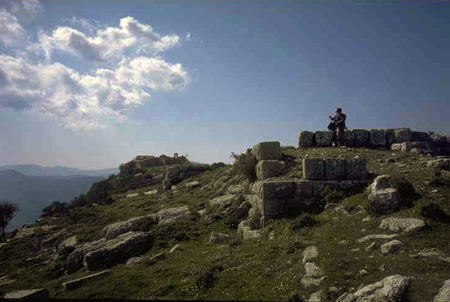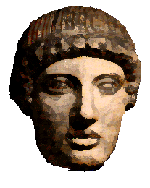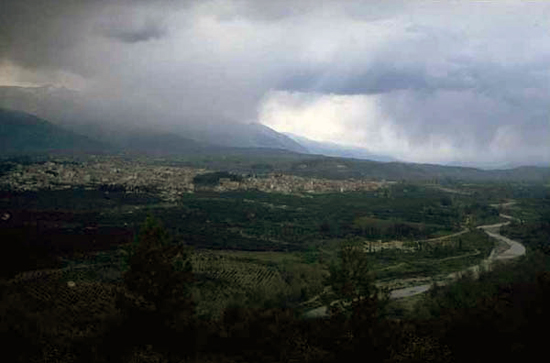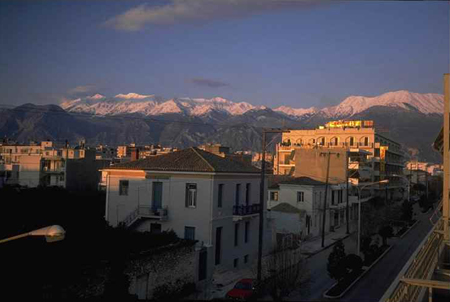Sparta
Exploring ancient Sparta
The View of Sparta from the Menelaion (Therapne)
If you are coming from Athens, turn left just before you cross the Eurotas, and take the road to Yeraki and Leonidio. After a couple of miles there is a very minor track off on the left - but it is signposted. This leads eventually to a turning place with parking by a small chapel - from where a path leads up the hill for a mile or so. On a clear day the view is amazing: but in bad weather (as in this picture) it is perhaps even more spectacular. Ancient Sparta was probably somewhat larger than the modern town - and being unwalled probably sprawled just as it does today.
The Menelaion itself, according to Pausanias, is on the site of a temple which contained the tombs of Helen and Menelaus. It was a very popular trip - men prayed for Menelaus' prowess, and women prayed for Helen's beauty: worth the climb and long walk - even if (like us) in the pouring rain! Behind it there are ruins of a Mycenaean palace dated around 1200 BC: similar to Nestor's at Pylos but smaller. So if it wasn't Menelaus', whose was it?
The Acropolis of Sparta
To the north of the modern town is the very extensive site of the ancient acropolis. The left-hand view is from the top: Taÿgetus is still snow-covered (the picture was taken in late March) - and the asphodel (foreground) is blooming.The view on the right is of the Hellenistic/Roman Theatre (what did they use it for? Not Athenian tragedies or comedies, presumably: although it's a wonderful idea to imagine a revival of the Lysistrata being performed here!).
The site of the Temple of Athena Chalkioikos is occupied by a sort of waterworks: it looks sinister enough to recall the story of King Pausanias, driven to seek sanctuary there as a result of accusations of sleaze by the ephors. They left him to starve - but brought him out at the very last minute so he wouldn't die on consecrated ground.
The Temple of Artemis Orthia
Entering Sparta from Tripoli or Athens there is a compulsory right turn into the town centre. Just here an insignificant track on your left leads down to the Eurotas, passing the temple of Artemis Orthia. It's hard to believe that this neglected ruin was once the centrepiece of Spartan religion. Here boys became men through a coming-of-age ritual which involved their being flogged on the temple steps until their flesh was torn to bleeding ribbons. According to Pausanias, the goddess was not satified until her altar was soaked with blood. The Romans - Sparta was a great tourist attraction for them - not only revived this charming ancient custom, but built a grandstand so they could watch in comfort. Its ruins can also be seen in the foreground.
Sparta - town centre
This is the view from the Hotel Cecil in the centre of modern Sparta. In ancient times the town was without walls - when you see the seemingly impassable barrier of Mount Taÿgetus (especially as here in late March under snow) you realise why they were unnecessary. You also wonder at the determination and fitness which made them cross the 6000ft range to annex Messenia. The modern town has an old-fashioned dignity about it - but you can't fail to be impressed by its overwhelming ordinariness. I love it!
Mount Ithome
A long way from Sparta - but essential to visit if you want to understand ancient Sparta. Cross Taÿgetus over the spectacular modern pass - this route was not a viable option for the old Spartans. Skilful map reading will be required to find the Peloponnese's best kept secret - the ancient city of Messenia, and, towering above it, Mount Ithome. Head for the village of Mavromati: it is nowhere near the modern town called Messene.
It was this stronghold that the Messenians - known to their Spartan masters as Helots - occupied whenever the Spartans showed signs of losing their iron grip on the conquered territory. Each time theSpartans dislodged them - until they eventually found an ally in the Theban Epaminondas, who gave them independence and a splendid new capital to spite his enemies. The remains of this capital are open and accessible - a massive site which would be on every tourist itinerary if they had ever heard of it! The walls and defences are the most impressive in Greece (only Syracuse or Selinus in Sicily can be compared). The remains of the town ( mostly Roman period) with its vast forum, stadium, temples and water-system will blow your mind. But first, you must make your pilgrimage to the summit of Ithome, to see what an incredible vantage point it is. There's a dirt road that contours nearly to the top - but there are (steeper) shortcuts if you watch out carefully. The northern slope, looking into Arcadia, is, if anything, even steeper - behind the sheep in the central view. On the right is Hopey, trying to make sense of the few confusing ruins. The very top is still a shrine - a disused monastery occupies the site of the temple of Zeus.





